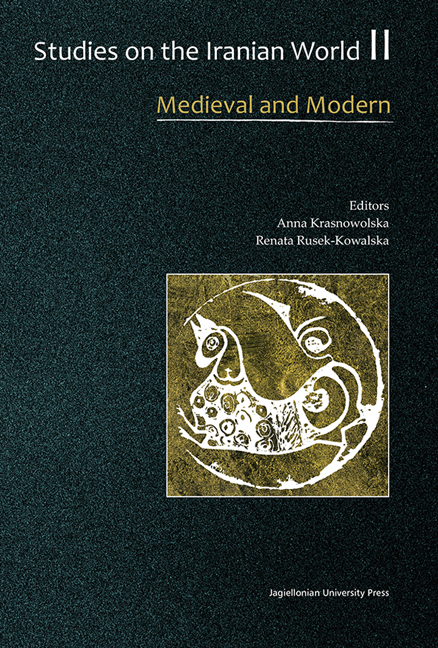Book contents
- Frontmatter
- Contents
- Foreword
- Linguistics
- Literature
- Religion
- History
- Arts
- The Reception and Illustration of Hafiz in Mid-Seventeeth-Century Iran
- Al-Muqaddasi's Ahsan al-Taqasim fi Ma‘rifat al-Aqalim and the Perception of the Built Environment in the Tenth Century
- Quelques réflexions autour d'un dessin de Michel François Préaux – peintre de la mission du général Gardane en Perse (1807–1809)
- Le cinéma de Kiarostami en prise sur le cinéma de Rossellini et Godard : rencontre, échange, superposition
- Where is Anna? What Happened to Elly? – Asghar Farhadi Rewrites and Re-Veils Michaelangelo Antonioni
- Social and Cultural Studies
Al-Muqaddasi's Ahsan al-Taqasim fi Ma‘rifat al-Aqalim and the Perception of the Built Environment in the Tenth Century
from Arts
Published online by Cambridge University Press: 12 January 2018
- Frontmatter
- Contents
- Foreword
- Linguistics
- Literature
- Religion
- History
- Arts
- The Reception and Illustration of Hafiz in Mid-Seventeeth-Century Iran
- Al-Muqaddasi's Ahsan al-Taqasim fi Ma‘rifat al-Aqalim and the Perception of the Built Environment in the Tenth Century
- Quelques réflexions autour d'un dessin de Michel François Préaux – peintre de la mission du général Gardane en Perse (1807–1809)
- Le cinéma de Kiarostami en prise sur le cinéma de Rossellini et Godard : rencontre, échange, superposition
- Where is Anna? What Happened to Elly? – Asghar Farhadi Rewrites and Re-Veils Michaelangelo Antonioni
- Social and Cultural Studies
Summary
SUMMARY
During the early medieval period, the Islamic world saw a proliferation of geographical writing. Among such treatises, the work of al-Muqaddasi (fourth/tenth-century geographer), Ahsan al-taqasim fi ma‘rifat al-aqalim, is the subject of this article as a case-study for the organization and originality of sections of his writing. Early Islamic geographical writing, generally, and al-Muqaddasi's work, especially, describes the built environment as precisely as the natural environment. This valuable source also deals with the conceptual ways people saw, conceived, and remembered the built environment. By contextualizing al-Muqaddasi's accounts in contemporary written sources, this paper aims to explore the following questions: to what extent can geographical accounts contribute to the study of individual buildings and towns? How do geographical accounts approach picturing early medieval Islamic towns? And how can these accounts contribute to studying the perception of architecture and the built environment at the time?
INTRODUCTION
During the period spanning from the tenth to the twelfth century, the Islamic world saw a proliferation of geographical writing, a practice that can be traced back to the seventh century, when new routes were created and itineraries recorded to enhance communication around the newly expanded Islamic realm, which in turn facilitated patronage within this discipline. Concurrently, the significance of Mecca in Islamic rituals meant that Muslims – including those recently converted to Islam – had to face the Ka'ba in their prayers and make the pilgrimage to Mecca. These changes encouraged a scientific study of the Islamic regions. Muslims were in close contact with the pre-Islamic cultures of the Near East, the Romano-Byzantine, and Indo-Iranian literary and administrative heritages, which were gradually incorporated into Islamic civilisation. Ptolemy's geographical treatise was translated into Arabic in the ninth century and there is evidence that the early Medieval Islamic geographers were familiar with and used Ptolemy's work as a source. For instance, the tenth-century writer of Hudud al-‘alam (The Limits of the World) refers to Ptolemy's work at least twice in his discussion of ‘Islands’ and ‘Mountains.
The distinguishing feature of the geography writers of this period is research through travel, and those who did not travel depended on earlier books for their treatises. Whether a geographer travelled or not is at times a matter of debate since not all the writers state how they compiled their work.
- Type
- Chapter
- Information
- Studies on the Iranian WorldMedieval and Modern, pp. 243 - 256Publisher: Jagiellonian University PressPrint publication year: 2015



